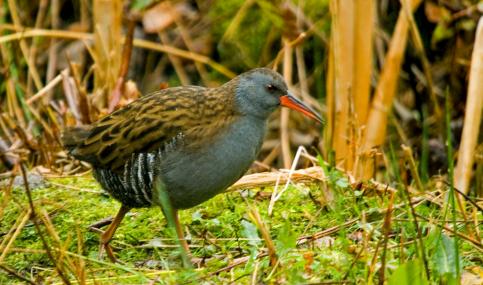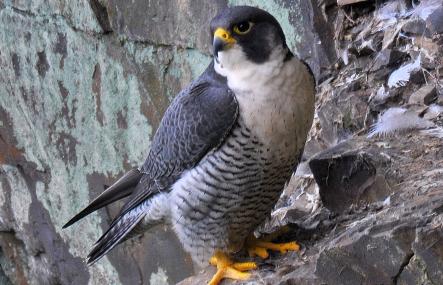Coot
A familiar bird of many of our wetlands, the coot is often seen on park lakes, ponds and rivers. They spend more of their time on the water than their relative the moorhen and will dive to catch small invertebrates and eat waterweeds. Unlike ducks, coots will bring their catch to the surface before eating it, leading to squabbles over food. Coots breed in spring, laying between six and nine eggs in nests amongst emergent vegetation. Coot chicks are black with orange fluff around the face and body; they are independent within two months of hatching.
Although coots are common birds, their wetland homes are under threat from development, drainage and pollution. The Wildlife Trusts manage many wetland nature reserves for the benefit of the wildlife they support. You can help by supporting your local Trust and becoming a member; you'll find out about exciting wildlife happenings, events on your doorstep and volunteering opportunities and be helping local wildlife along the way.

Moorhen
Although moorhens are common birds, their wetland homes are under threat from development, drainage and pollution. The Wildlife Trusts manage many wetland nature reserves for the benefit of the wildlife they support. You can help by supporting your local Trust and becoming a member; you'll find out about exciting wildlife happenings, events on your doorstep and volunteering opportunities and be helping local wildlife along the way.

Water Rail
A small relative of the moorhen and coot and about the same size as a redshank, water rails live in reedbeds and freshwater wetlands where they feed on invertebrates and small fish. Secretive and rarely seen they are more often heard calling - sounding like a piglet squealing, they are unmistakeable. Between 700 and 1,400 pairs nest in Britain.
Although water rails are not currently declining their reedbed and wetland homes are under threat from development, drainage and pollution. The Wildlife Trusts manage many wetland nature reserves for the benefit of the wildlife they support. You can help by supporting your local Trust and becoming a member; you'll find out about exciting wildlife happenings, events on your doorstep and volunteering opportunities and be helping local wildlife along the way.

Pheasant
A very familiar gamebird, pheasants are large, colourful and have a long tail. Common in farmland and woodland throughout Britain, the males' loud, sharp, croaking call can be heard resonating through the countryside before the bird is actually seen. Pheasants eat seeds, berries, leaves and insects; they roost in trees and can form flocks in winter. During the breeding season, one male may mate with many females, which hatch and raise the chicks alone.
The pheasant is an introduced species in Britain. Some introduced species can become a pest, both to humans and to other wildlife, while others can live easily alongside our native species. Pheasants in large numbers can cause significant damage to woodland ground flora, but as a gamebird, it's possible that the introduction and success of the pheasant has helped to take pressure off certain native species. The Wildlife Trusts record and monitor our local wildlife to understand the effects of various factors on their populations such as the introduction of new species. You can help with this vital monitoring work by becoming a volunteer - you'll not only help local wildlife, but learn new skills and make new friends along the way.

Grey Partridge
A plump, round gamebird the grey partridge is locally common but now thinly distributed and becoming scarce in most parts of the country. A farmland bird, it feeds on seeds, leaves and small invertebrates. When disturbed, grey partridges prefer to run instead of fly but they will fly low to the ground if necessary. They breed in open scrub and farmland, close to hedges or other vegetation, laying their eggs on the ground in a grass-lined scrape.
Grey partridge populations have suffered severe declines due to the loss of their traditional grassland and farmland habitats through agricultural intensification. The Wildlife Trusts work closely with farmers and landowners to promote wildlife-friendly practices. We are working towards a 'Living Landscape': a network of habitats and wildlife corridors across town and country which are good for both wildlife and people. You can support this greener vision for the future by joining your local Wildlife Trust.

Red-legged Partridge
A plump, round, gamebird the red-legged partridge is common in farmland where it feeds on seeds, leaves and small invertebrates. When disturbed, red-legged partridges prefer to run instead of fly but they will fly short distances if necessary. They breed in open scrub and farmland, laying their eggs on the ground.
The red-legged partridge is an introduced species in Britain. Some introduced species can become a pest, both to humans and to other wildlife, while others can live easily alongside our native species. As a gamebird, it's possible that the introduction and success of the red-legged partridge has helped to take pressure off certain native species. The Wildlife Trusts record and monitor our local wildlife to understand the effects of various factors on their populations such as the introduction of new species. You can help with this vital monitoring work by becoming a volunteer - you'll not only help local wildlife but learn new skills and make new friends along the way.

Black Grouse
The black grouse is a large gamebird about the same size as a female pheasant. Males have a lyre-shaped tail which they raise and fan out in display. These displays are known as 'leks' and males will gather at traditional sites and display to gain dominance and win over females which watch from the surrounding vegetation. Between six and eleven eggs are laid in May in a concealed, moss-lined scrape in the ground; the chicks are independent after about three months.
Black grouse populations have suffered severe declines due to the loss of their natural, heathland habitats: over the last 50 years up to 40% of heather moorland has been lost to commercial forestry and overgrazing. The Wildlife Trusts are working to restore and protect our heaths by promoting good management, clearing encroaching scrub and implementing beneficial grazing regimes. This work is vital if our heathland habitats are to survive; you can help by supporting your local Wildlife Trust and becoming a member or volunteer.

Red Grouse
The red grouse is a plump gamebird about the same size and shape as a artridge. It feeds on heather and can be found on upland heathlands and moorland; it's often spotted as it's flushed from the heather, suddenly flying upwards with rapid, whirring wing-beats. There are actually two subspecies of red grouse: Lagopus lagopus scotia (the red grouse of the British Isles) and Lagopus lagopus lagopus (the willow grouse of Scandinavia and Alaska).
Red grouse populations are in decline due to the loss of their natural, heathland habitats: over the last 50 years up to 40% of heather moorland has been lost to commercial forestry and overgrazing. The Wildlife Trusts are working to restore and protect our heaths by promoting good management, clearing encroaching scrub and implementing beneficial grazing regimes. This work is vital if our heathland habitats are to survive; you can help by supporting your local Wildlife Trust and becoming a member or volunteer.

Merlin
The merlin is a small falcon, not much bigger than a blackbird. Merlins feed on small birds, especially meadow pipits which they chase in flight, low to the ground. Its small size also allows it to 'hang' in the breeze as it pursues its prey. They nest on the ground, amongst the heather. In the winter, our population of merlins increases as breeding birds are joined by migrants from Iceland in search of warmer climes.
The merlin suffered a devastating population crash in the 20th century due to habitat loss and pesticide poisoning but is now making a recovery. To ensure their continued success, The Wildlife Trusts work closely with farmers and landowners to promote wildlife-friendly practices. We are working towards a 'Living Landscape': a network of habitats and wildlife corridors across town and country which are good for both wildlife and people. You can support this greener vision for the future by joining your local Wildlife Trust.

Peregrine Falcon
The peregrine falcon suffered from persecution and pesticide poisoning in the early 20th century and until recently was only found in the north and west of the country. Over the last couple of decades they have been doing very well and in recent years they have found some unusual nest sites; including Derby Cathedral and the BT Tower in Birmingham! These tall, city structures replicate the precipitous cliff edges that they would naturally nest on.
Like many of our birds of prey, the peregrine falcon was severely persecuted in the UK. Thankfully, peregrines are now increasing in number and can even be spotted in our towns and cities. To ensure their continued success, The Wildlife Trusts work closely with developers, farmers and landowners to promote wildlife-friendly practices. We are working towards a 'Living Landscape': a network of habitats and wildlife corridors across town and country which are good for both wildlife and people. You can support this greener vision for the future by joining your local Wildlife Trust.
